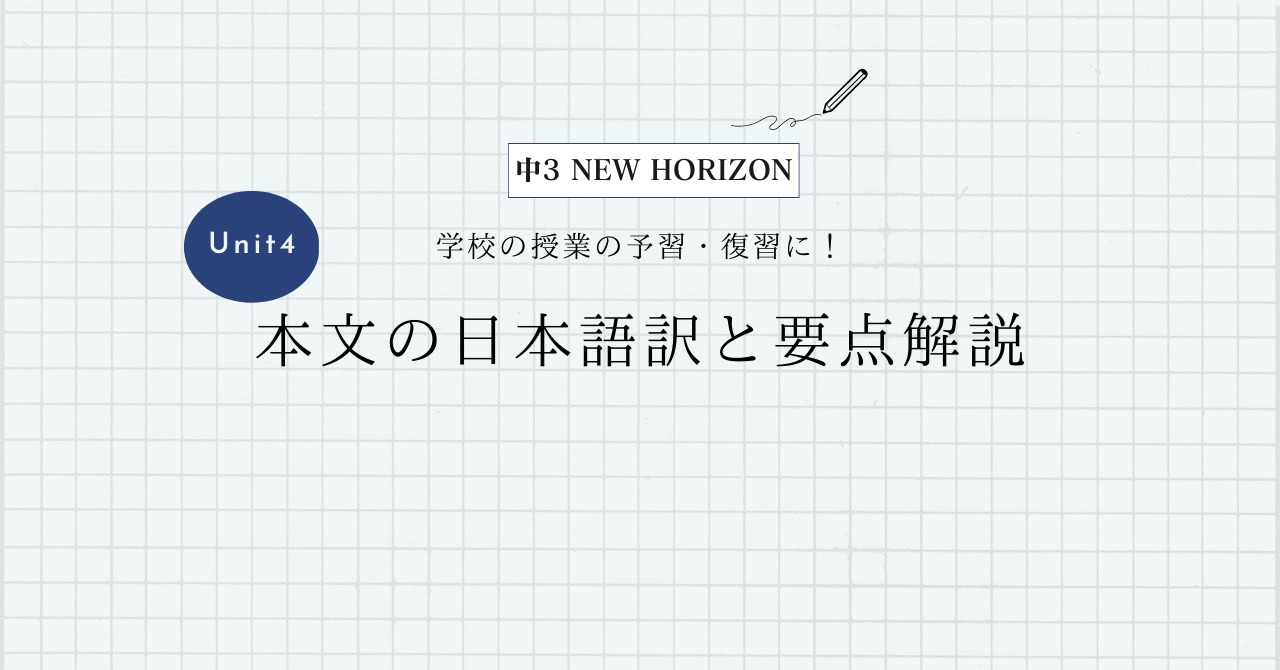東京書籍 中学3年生 NEW HORIZON(ニューホライズン) Unit4 Read & Think1の本文の日本語訳と重要箇所の解説です。
Unit4-1,4-2とRead & Think2の解説はこちらからご覧ください。
>中3NEW HORIZON Unit4 Scene1 本文和訳
>中3NEW HORIZON Unit4 Scene2 本文和訳
>中3NEW HORIZON Unit4 Read & Think2 本文和訳
- Unit4 Read & Think1 本文と日本語訳
- Unit4 Read & Think1 重要事項の解説
- What kinds of troubles did these people have?
- When the earthquake began, I didn’t know what was happening.
- After the terrible shaking, I ran out of the house with my wife.
- We didn’t know where to go, so we drove to a supermarket parking lot.
- We stayed in our car for five hours.
- We were too scared to get out.
- Finally, we spoke to a police officer passing by.
- He guided us to the local shelter.
- I didn’t know about it until then.
- My friend and I took a day trip by train.
- On the way back, there was a big earthquake.
- Trains stopped running.
- The announcements at the station were in Japanese.
- We looked on the internet, but all the latest information there was in Japanese, too.
- Fortunately, there was a woman speaking to some travelers in English.
- She told us how to go back.
- Unit4 Read & Think1 まとめ
Unit4 Read & Think1 本文と日本語訳
What kinds of troubles did these people have?
「この人たちはどんな困難に見舞われましたか?」
Case 1 「事例1」
When the earthquake began, I didn’t know what was happening.
「地震が始まったとき,私は何が起きているのか分かりませんでした。」
After the terrible shaking, I ran out of the house with my wife.
「恐ろしい揺れの後,私は妻と一緒に家の外に逃げ出しました。」
We didn’t know where to go, so we drove to a supermarket parking lot.
「私たちはどこに行くべきか分からなかったので,スーパーの駐車場まで車で行きました。」
We stayed in our car for five hours.
「私たちは5時間車の中にいました。」
We were too scared to get out.
「怖すぎて外に出られませんでした。」
Finally, we spoke to a police officer passing by.
「最終的に,私たちは通りかかった警察官に話しかけました。」
He guided us to the local shelter.
「彼は地元の避難所に私たちを案内してくれました。」
I didn’t know about it until then.
「それまで避難所について知りませんでした。」
Case 2 「事例2」
My friend and I took a day trip by train.
「友達と私は電車で日帰り旅行をしていました。」
On the way back, there was a big earthquake.
「帰りの途中で,大きな地震がありました。」
Trains stopped running.
「電車は走るのをやめました。」
The announcements at the station were in Japanese.
「駅のアナウンスは日本語でした。」
We looked on the internet, but all the latest information there was in Japanese, too.
「私たちはインターネットを見ましたが,そこの最新情報も日本語でした。」
Fortunately, there was a woman speaking to some travelers in English.
「幸運にも,英語で旅行者と話している女性がいました。」
She told us how to go back.
「彼女は私たちに帰り方を教えてくれました。」

Unit4 Read & Think1 重要事項の解説
What kinds of troubles did these people have?
“What kind of~”で「どんな種類の~」といった意味になります。
“kind”は形容詞で「優しい,親切な」,名詞で「種類」という意味があります。
“trouble”は「困難,悩み」という名詞で,“these”は“this”の複数形で「これらは,これらの」という代名詞ですね。
When the earthquake began, I didn’t know what was happening.
この文では「接続詞when」が使われていますね。
“earthquake”は「地震」,“began”は“begin(始まる)”の過去形です。
“what was happening”は「間接疑問文」になっています。
“happen”は「起こる」という動詞で,“what”を主語とする「過去進行形」にもなっていますね。
After the terrible shaking, I ran out of the house with my wife.
“after”は前置詞で「~のあとで」という意味,“terrible”は「恐ろしい」という形容詞です。
“shaking”は「揺れ」という名詞ですね。
“run out of~”は「~から逃げ出す」という意味で,“wife”は「妻」という名詞になります。
We didn’t know where to go, so we drove to a supermarket parking lot.
“where to go”は「疑問詞+不定詞」の形になっていますね。
“so”は「だから」という接続詞で,“drove”は“drive(運転する,車を出す)”の過去形です。
“parking lot”は「駐車場」になります。
We stayed in our car for five hours.
“for 時間”で「~間」という意味になります。
We were too scared to get out.
“too 形容詞/副詞 to 動詞の原形”は「~すぎて…できない」という否定的なニュアンスの文になります。
“scared”は「怖い」という形容詞で,“get out”は「外へ出る,降りる」という意味です。
そのため「怖すぎて外に出られなかった」となりますよ。
Finally, we spoke to a police officer passing by.
“finally”は「最終的に」という副詞です。
“speak to 人”は「人に話しかける」という意味ですね。“police officer”は「警察官」です。
“pass by”は「過ぎ去る,通りかかる」という意味で,ここでは「現在分詞」になって直前の“police officer”を修飾していますね。
He guided us to the local shelter.
“guide”は「を案内する」という動詞です。
“local”は「地元の」という形容詞で,“shelter”は「避難所」という名詞になります。
I didn’t know about it until then.
“it”は“the local shelter”を指していますね。
“until”は「~まで」という前置詞で,“until then”で「それまで」となります。
My friend and I took a day trip by train.
“take a day trip”で「日帰り旅行する」となります。
“by 乗り物”は「交通手段」を表す重要な表現です。乗り物の前に冠詞や所有格を入れないようにしましょう。
ちなみに「徒歩で」は“on foot”ですよ。
On the way back, there was a big earthquake.
“on the way back”で「帰りの途中で」という意味です。
“on the way back to~“だと「~に帰る途中で」,“on the way back from~“だと「~から帰る途中で」となります。
また,この文は「there構文」になっていますね。
Trains stopped running.
“stop 動名詞”は「~するのをやめる」となります。
“stop 不定詞”にすると「~するために立ち止まる」となってしまうので,“stop”の後は「動名詞」と「不定詞」の書き換えはできませんよ!
The announcements at the station were in Japanese.
“announcement”は「発表,アナウンス」という名詞ですね。
“in 言語”は「~語で」という意味になります。
We looked on the internet, but all the latest information there was in Japanese, too.
“latest”は「最新の」という形容詞です。
文末の“, too”は「~も」という意味で肯定文のときに使えますね。
Fortunately, there was a woman speaking to some travelers in English.
“fortunately”は「幸運にも,ありがたいことに」といった副詞です。
この文も「there構文」になっていて,“speaking”は「現在分詞」で直前の“a woman”を修飾していますね。
“traveler”は「旅行者」という名詞ですね。
She told us how to go back.
“tell 人 もの”で「人にものを言う,伝える,教える」といった意味になります。
“how to 動詞の原形”は「~のしかた」と訳すことが多いですね。
“go back”は「戻る,帰る」という意味です。
Unit4 Read & Think1 まとめ
以上がUnit4 Read & Think1の日本語訳となります。
ここでは「現在分詞」や「疑問詞+不定詞」が使われていますね。しっかり理解していきましょう!
>中3NEW HORIZON Unit4 Scene1 本文和訳
>中3NEW HORIZON Unit4 Scene2 本文和訳
>中3NEW HORIZON Unit4 Read & Think2 本文和訳
何か分からない点や他に解説してほしい点があれば,お気軽にコメントしてください!



コメント